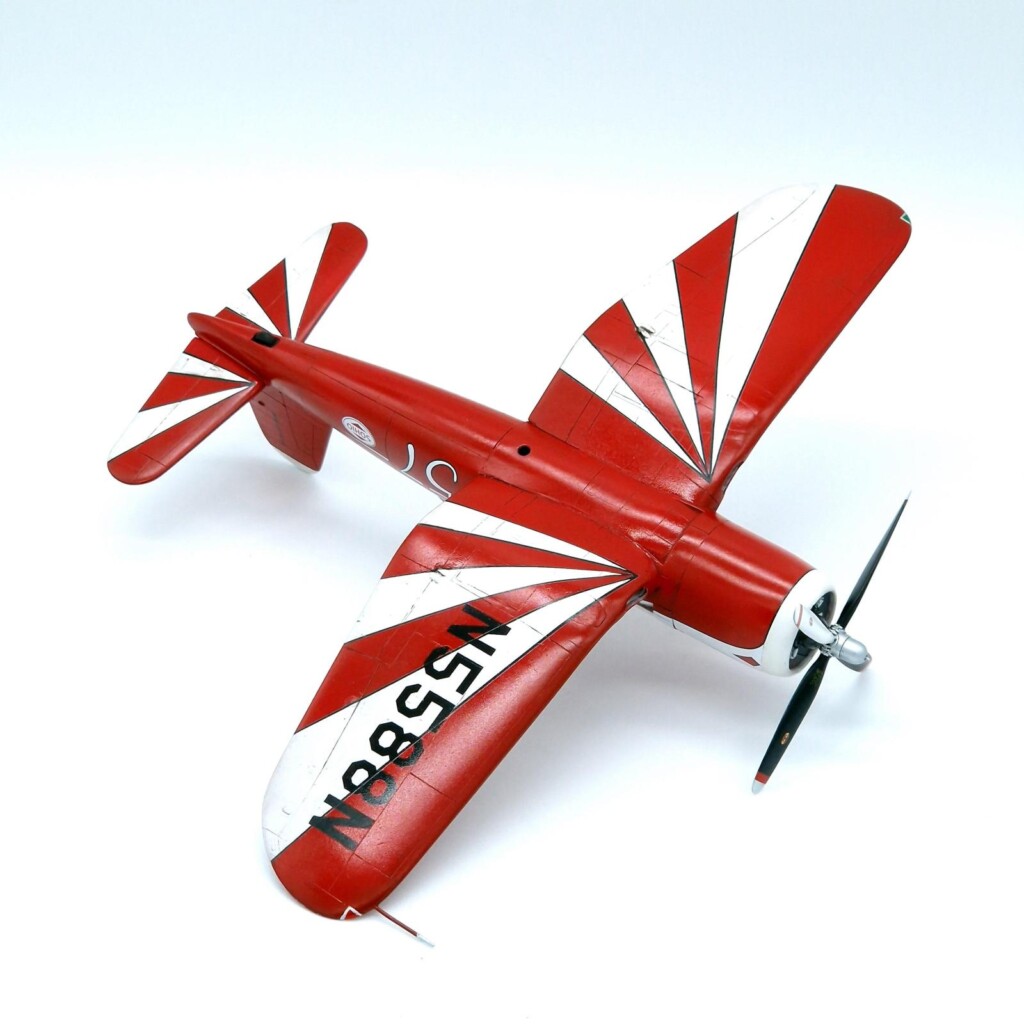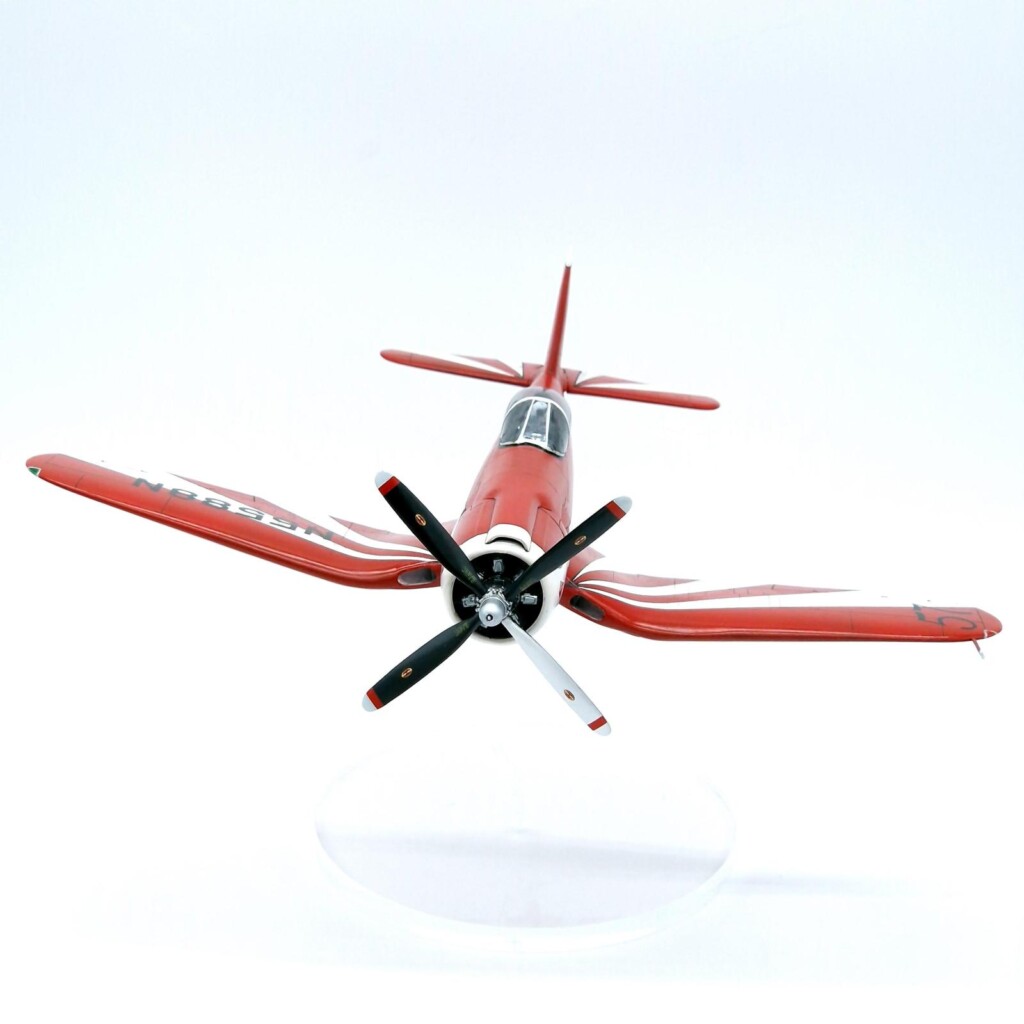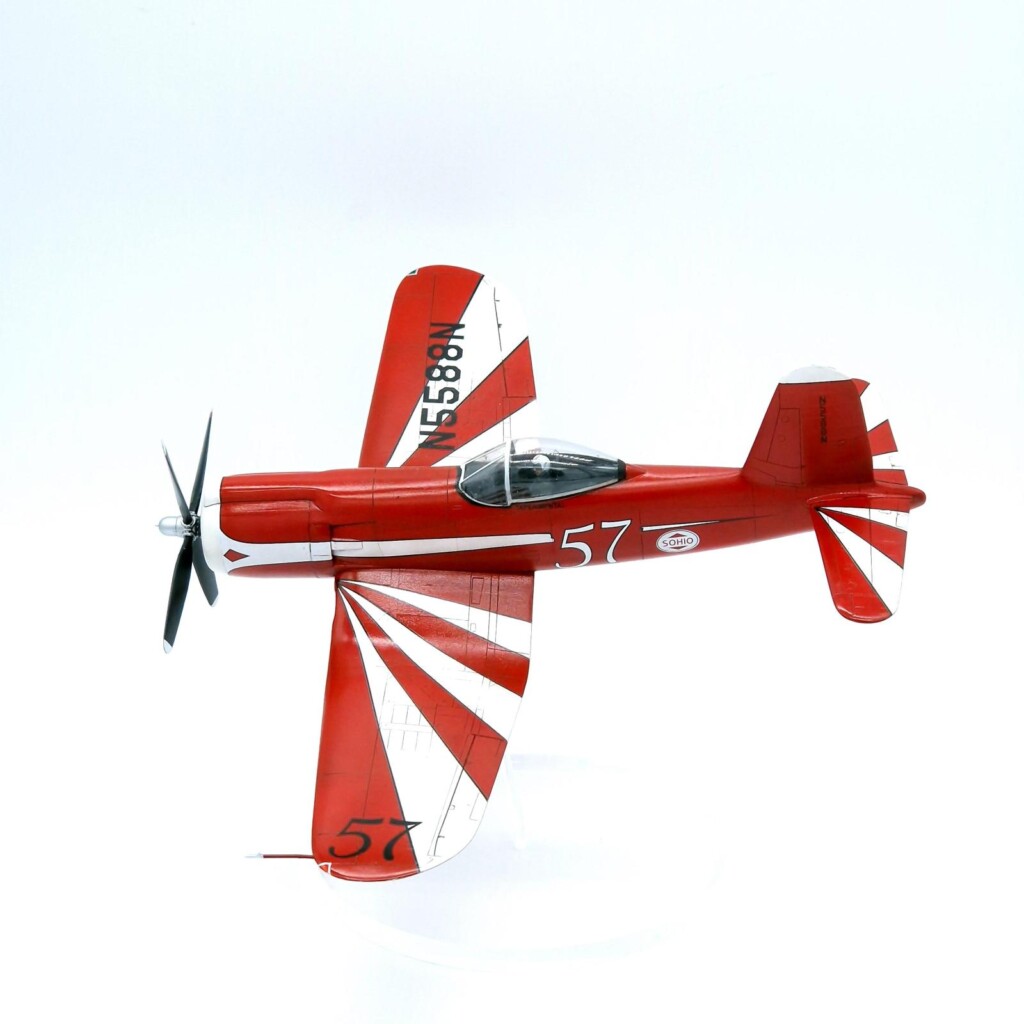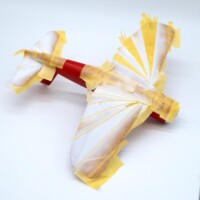Special Hobby F2G-1, 1/48. 'Fly Fast, Turn Left'
Another Corsair for the collection, this Special Hobby kit was bought around 2 years ago and when I opened the box I immediately realised I wasn't ready for this sort of built and left it in the pile.
This is Special Hobby's rendition of the F2G Super Corsair in 1/48. Special Hobby's niche is producing plastic injection moulded kits of very niche subjects that are generally otherwise unavailable in plastic, the Super Corsair is no exception with the only alternative being a resin conversion kit for the Tamiya Corsair. Personally if you can get your hands on it I'd lean towards the resin route, but I'm not sure if there are actually any out there and either way Lone Star Models doesn't ship outside of the states which means it was never an option for me anyways.
The F2G Super Corsair
Not a huge amount seems to be clear about why the Super Corsair came to be beyond the simple answer of trying to fit the massive Pratt & Whitney R-4360 Wasp Major engine into a Corsair. This engine was a gigantic 24 cylinder engine, arranged into 4 rows, which had the potential to pump out over 1,000hp more than the R-2800 Double Wasp powering the F4U.
Vought is similar to Supermarine in the sense that both had an aircraft with great potential, but were otherwise relatively small companies with not enough production capability to fill the quota of what was ordered. For Supermarine this meant factories such as that owned by Vickers became the primary producer of the the Spitfire, for Vought this meant that Brewster and Goodyear were given the task of producing the Corsair.
Whilst Brewster turned out to be a massive failure of a company with their products being accused of 'outright sabotage', and their Corsairs having the unnerving tenancies to lose wings in high G turns, Goodyear became a huge producer of the aircraft. Whilst some may think the company famous for producing rubber tyres is a strange fit, Goodyear is of course famous for their lighter-than-air ventures into flight in the form of airships and blimps. This meant that Goodyear was a company with a long history of working with aluminium (before it become the go-to building material for aircraft), and had gigantic facilities at hand for production. Designed the FG-1 Corsair, Goodyear would produce an impressive 4,008 machines during the war out of the 12,571 total Corsairs produced (including post-war production).
In 1944 the design and development of the a Corsair with the R-4360 engine, to be designated F2G, was begun. This venture was solely down to Goodyear as Vought was currently fully occupied with the F4U-1C/D and F4U-4 development and production. It's commonly accepted that the Super Corsair was designed specifically to meet the new Kamikaze threat, however this is surely a popular myth as the Super Corsair entered development in early 1944, months before both the Japanese accepted kamikaze as a tactic in June '44 and launched their first specialised kamikaze attack in October of that year. Whilst it's undoubtable that the Super Corsair was assessed for the role of dealing with kamikaze, this certainly isn't what caused the aircraft to enter development. Indeed it seems likely given the timeline that the intention was to use the much increased power offered by the F2G's engine to allow a larger payload to be carried in ground attack operations. Of note the range of the Super Corsair is listed to be increased, however I'm not sure if the range estimates for the machine actually include weapons and ammo.
Early into development it was immediately realised that the massive engine was going to be a difficult beast to tame, the huge torque generated by the engine made take-offs and landings (particularly a go-around from a carrier) very hairy, control flutter was another noted issue. Along with a bubble canopy being added to the design (supposed the prototypes used the P-47 bubble) from the get-go, very quickly a new redesigned tail was added as a necessity to try and tame the beast. This new tail featured a larger rudder, but also a secondary small rudder that was linked to flap usage and would deflect automatically as they were lowered to help give the aircraft more control against the engines torque at low speed.
As quick as the Navy was to order the Super Corsair, they also very quickly wrote off the idea of it being used on a Carrier due to these issues. 418 F2G-1 Super Corsairs were ordered for the Marines, with only 10 F2G-2s with tailhooks and hydraulic wing folds were ordered likely purely for testing, this give another strike against the idea of the Super Corsair being designed to fight the new kamikaze threat. Even so, the new Bearcat had very comparable performance to the Super Corsair in climb rate and acceleration whilst being actually carrier capable.
When the war ended so did the interest in the Super Corsair. The Corsair could carrier heavier loads with the F4U-4, whilst the F2G could carry even more the issues outweighed those pros. Furthermore as an interceptor the Bearcat was now available and fully designed, whereas the F2G still had design hurdles to overcome. Post-war the aircraft of course became famous as an air racer with its powerful new engine offering supreme low-altitude performance as expected.
The Kit
Well, where to begin? This F2G comes in three versions, one being at XF2G prototypes, one being this red Race 57, and another being the blue Race 74.
Firstly you'll need to do some work to get this thing to go together, a lot of it. The fuselage lacks any sort of pins to aid with joining which means the fuselage halves are very hard to get straight. The cockpit really lacks any detail, and the details it has are quite inaccurate, and of course the cockpit tub doesn't fit well into the fuselage. The engine is resin, but naturally nearly none of it is visible when the model is assembled. The elevators just, would. not. stay. I glued them many times and they would always wiggle out due to poor surface-to-surface joins. Actually, I've never built a kit where the plastic seems adverse to being glued, its hard to explain but I just never felt the glue was as strong as normal. Also the vacuum formed canopy in my eye looks way too big to be correct, it just doesn't match references and looks far oversized.
Of course some other issues are unique to the racers, gun ports and ejection chutes need to be filled, the wing with its raised fabric parts also needs to be removed. The decals for the white stripes are just a bad idea, whilst they actually are very strong and opaque there is no way to make them look straight over the lumps and bumps of a wing or elevator. Furthermore I'm not sure what date these decals depict but they certainly don't depect the machine of the last decade or two, with some decals either missing or the wrong size for the aircraft seen today/at the time of the kits release.
Is it fun? Nope.
Does it build an accurate model? More accurate than not, but has some issues for sure.
Do I recommend it? Nope.
Is it the best way to build a Super Corsair? Ultimately yes, and that is Special Hobby's schtick of making a niche subject matter a reality, and kudos to them for doing that as this hobby is certainly a better place with the option for the weird and wacky models they produce, that being said I'm glad this build is over and it's certainly not my favourite or proudest achievement. It fought me at every step and whilst some issues were due to the kit, some such as paint issues were my own, and unfortunately a race plane does not lend itself to having mistakes simply covered over with some weathering.
That being said I'm glad I built it if for no other reason than an excuse to get a bit more familiar with the dreaded material known as resin, which certainly has become handy with a subsequent build.






















You're under-selling both your skills and the model, Harvey. You did a very creditable job here on getting Race 57 as she is currently.
Having been around the real "Race 57," I can assure you the kit is accurate. By that I mean accurate if you are referring to the modern airplane. "Race 57" was restored some 20 years ago, from a very bad state. The cockpit was rebuilt to what is in the kit, which has little to do with the original F4U-4 cockpit. The carb intake is modern, rather than the "Dog House" of Thompson Trophy days, and the wing has the metal outer wings of the F4U-5, which were used in the restoration. There are some later releases of the kit that have the original FG-1D wings with fabric surfaces. Having sat in it out at Chino, the canopy is that big.
The problem for modelers is that the available research has to be researched in order to find all this out, so if one is going by descriptions of the original airplane, things get puzzling.
Here's a photo taken back in 2006 when the airplane was at Chino for one of the shows. You can see that you actually got a more accurate model than you thought you did.
1 attached image. Click to enlarge.
Thank you for that! That being said I still think the canopy is a bit too.. bulbous.. compared to photos like the one provided, but I'll defer to your judgement with real world experience. It may be that the pilot sits too low in the cockpit and causes that illusion, after all the kit definitely isn't intended to have anything in there
I do think the kit provides an amalgamation of decals for different eras of Race 57, or at least aren't the correct size for what it seems to be painted up today.
Great looking F2G racer, Harvey!
Best,
Mike
Thank you! Regarding the F4U-1C there is a build thread up last year, it was some small styrene bits put on for the bulges and the cannons IIRC were from a Hurricane brass set. A Mustang Mk.Is cannons would have been an even better fit. Unfortunately no aftermarket for the 1C!
Love it, Harvey, the model, your write-up, and, especially your photos.
Thank you!
Harvey, @scalerambush
You are being way too hard on yourself, as I believe this looks magnificent. You have done an outstanding job with it.
I have seen the original Race 57, many years ago when it was owned by a man named Harry Doan. At the time, Harry also owned two other Corsairs. He was tragically killed while flying his Skyraider at the TiCo Airshow. He flipped it over upside down and he was actually suffocated by his own body weight while hanging upside down from the seat harness.
Shortly afterwards, his wife sold off his collection of Warbirds. Race 57 changed hands several times until it was restored by Bob Odegard.
What Tom Cleaver @tcinla
said about the "doghouse" is true. It's currently different from how it originally was.
This skinny little kid in this picture was me, way back around 1977 or 78, when the TV show "Blacksheep Squadron" was on the air and not re runs as it is today. We lived about 10 miles from Harry's shop so I got to watch the progress on the restoration of his F4U-1A, bureau number 17995.
Here you can see it after the engine was installed.
A year or so later they had the outer wings mounted.
This is how it looked shortly after Harry started flying it regularly. I took this picture at the Spruce Creek Fly Inn, probably around 1981 or 82. This was the first restoration, and it was one of the earliest Corsairs flying at the time. At this time it was painted up as Tommy Blackburn's "Big Hog" from VF-17.
Harry didn't do anything to Race 57 while he owned it, to the best of my knowledge. It sat at his shop while Harry had his crew restore this early Corsair I posted the pictures of. Sadly, I don't have any pictures of Race 57 when he owned it.
When I read that it had been fully restored to airworthy status, and was being flown, and then I saw the photos of it showing the quality of the work performed on it, I was a VERY happy man.
As far as Brewster goes, they suffered mainly from management troubles. They were tasked with developing the short, and "short short" wingtips for use on the FAA Corsairs, because as the original Corsair was delivered, when the wings were folded, the plane was too tall to fit into the hangar area below decks on the British carriers. Later on when the tail wheel strut was lengthened to help with forward visibility while taxiing, the problem became even worse.
Brewster also was developing what was called a "High Lift" wing for the Corsair, but not too much is known about this. One other project that Brewster worked on was the fuselage mounted centerline bomb rack. Brewster built aircraft were just as good as the ones built by Vought or Goodyear, however they suffered from manufacturing cost over runs, and they couldn't concentrate mainly on production, because of the special projects that I mentioned above. The majority of the Brewster built Corsairs ended up as "Lend Lease" aircraft with the FAA, where they served well. Brewster's main problem was one of management, and also one of keeping a work force staff retained, also which was a problem that was created by Brewster management.
This Race 57 Corsair just so happens to be my all time favorite aircraft, from any era, hands down.
You have done a magnificent job with it, and thanks for sharing this beauty with us.
I definitely clicked on the "Like" button. By the way, Harry's F4U-1A Corsair is now in South America, in a museum in Brazil.
Very interesting, thank you for sharing!
I still am not sure if Brewster aircraft can be truely considered built as well as the rest considering both the FAA and US military refused to put them in the front-line due to the wings falling off situation, whether that was a regular issue or happened only a couple times and was fixed I couldn't say. I truly don't actually know where the FAA put the 400~ they got but theres no references I can find in the couple of books I've got or online that say the Corsair Mk.III went anywhere noteworthy other than training squadrons
Harvey R. (@scalerambush)
I recently stumbled across some information about Brewster Corsairs and I wanted to share it with you.
It seems that Brewster Corsairs were used by the FAA in front line service. I recently received a wonderful gift. It's a book about the restoration of the worlds only surviving Corsair in the original paint / colors. Corsair KD-431 by David Morris
Mine is the updated edition and it includes new information that wasn't included in the first edition.
Here's a list of the FAA Squadrons that flew the Brewster built Corsair, as listed in the book. The book lists the units as "Front Line Squadrons".
As far as the wings folding up in flight:
I started digging around on Joel Baugher's serial number database website. I ran across a lot of early "Birdcage" Corsairs that were lost on Stateside training flights, (many from the nearby Jacksonville or Green Cove Springs Naval Air Stations), but some were also lost in this manner while in service overseas in the Pacific. Some of these Corsairs listed in the data base had the reason listed for the loss being described as "Wing folded up during flight, pilot KIA", or something similar.
The majority of these birdcage F4U's were Vought built, with Goodyear only manufacturing 299 airframes, and some of these 299 were retained by Goodyear for test purposes and eventual F2G work.
This wing fold problem carried over into the early "raised cabin" Vought and Goodyear built planes too, so it was not only a Brewster problem it seems.
I'm beginning to think this could have been a design fault, and not something that was Brewster's fault as it is reported. There had to be a reason why some of the Goodyear Corsairs were delivered without folding wings, and it's likely not just because they were destined for use on land. They would have been able to transport more aircraft overseas with the wings folded, and not fixed. So I would bet there had to be another hidden, possibly more ominous reason why this was done.
This perceived design flaw "could" have been another reason besides the blame Brewster one we are familiar with.
The problem seemed to magically "disappear" shortly after this time frame, as I was not able to locate any more wing fold up in flight problems afterwards. I might have missed some though, as I'm not perfect.
I believe the wing fold fault was fixed, re engineered or what have you. This is not something you want to have happen on a front line fighter. Sadly we lost quite a few young men because of this problem.
The Corsair is still my favorite aircraft ever, and your model looks incredible.
Cheers.
Thank you for the information, very interesting to see.
And also I think I might have to ask Santa for that book this christmas
Harvey R. (@scalerambush)
I do think you will enjoy the book. I am currently in the process of reading it from cover to cover. They mention the Brewster Company quality control and management / labor problems in the first chapter, but they also mention how some Brewster subcontracted assembly parts were used in construction of some Goodyear Corsairs. This book is fascinating to me, but then again I'm a Corsair geek. Get a copy. I don't think you will regret it. There are two versions. Make sure that you get the new "revised" edition with the latest updates. It will have the same cover as mine.
I'll echo all the above and affirm that you've created a handsome model of a gorgeous aircraft. I know SH is not especially relaxing to build, but had you not said anything, I would have never suspected build issues. Paint work, photos, and write up are fantastic and a pleasure to look at.
Thank you! Still having issues with some photos so I tried to upload a photo of some major issues caused by the decals but no joy. I suppose for me I see the lack of detail caused by repaintings/sanding/etc but the camera doesn't pic that up too much
Excellent allover, Harvey! Model and write-up are second to none.
Congratulations!
Thank you very much!
Harvey, awesome build! You made a great looking Corsair, especially a unique one. And great read on the history and build.
Another quality build, Harvey @scalerambush
Personally I do prefer a Corsair with its original canopy, but nevertheless this 57 looks amazing.
Thanks for the historical part.
Well done.
I definitely agree, if this kit was nicer I'd probably do another US Navy one for a side-by-side
That is one colorful (and large-nosed) Corsair! Looks fantastic - excellent paintwork.
Sweet looking Corsair!